What is Momordica charantia: an overview of the exotic vegetable, the stages of its cultivation and medicinal properties
Increasingly, exotic plants grown by domestic gardeners on their plots are found on Russian markets. Among them, fruits with needle-like yellow skin and red granular pulp are of particular interest. This unusual vegetable has a beautiful name - “Momordica charantia”. It is actively grown by gardeners around the world.
Momordica charantia is rapidly gaining popularity in our country. This is explained not only by the interesting appearance and taste of the vegetable, but also by its medicinal properties. The fruits are used to prepare various dishes and are used in folk medicine. Why this plant is useful and how to grow it in your garden - read on.
What is Momordica charantia
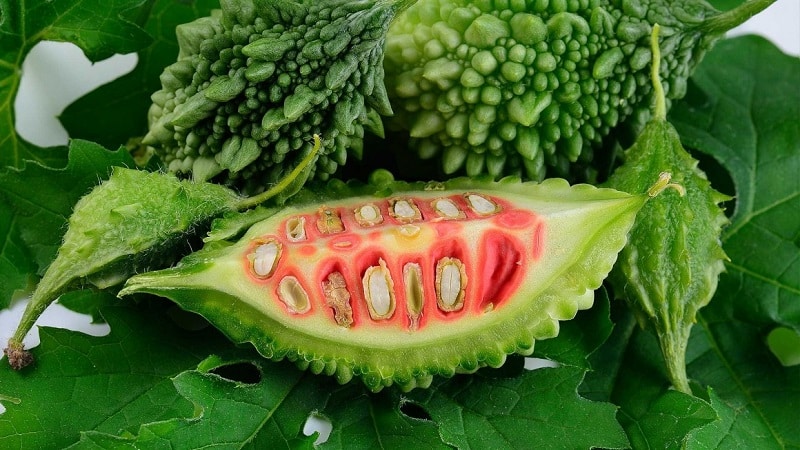
Momordica charantia is an annual plant from the pumpkin family.. It is a herbaceous vine. This vegetable comes from Asia, where it is actively used for preparing various dishes.
The name “momordica” is not often used among people. This vegetable is usually called:
This is a heat-loving plant. In our country, it is grown in open ground only in the southern regions. In the central and northern parts of Russia, momordica is planted in a greenhouse or under a film cover.
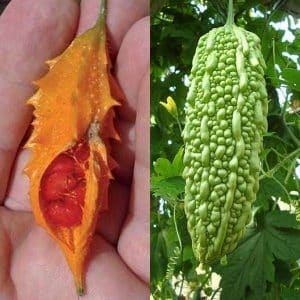
Bitter cucumber looks very unusual. It has an oblong shape and a dense peel covered with projections resembling needles (see photo).
Inside the vegetable there is light yellow pulp and seeds with a red shell. The seeds, pulp, flowers and leaves of the plant are eaten.
The taste of the fruit depends on the stage of its development. When they are still green, the flesh is crisp and crisp, reminiscent of a cucumber. When ripe, the vegetable becomes bitter. The seeds of green fruits are also bitter. When the peel of the vegetable turns yellow, a juicy pericarp with a pleasant sweet taste will form around the seeds. It is often characterized as a cross between persimmon and pumpkin.
Composition and nutritional value
Momordica charantia not only has an unusual appearance and pleasant taste, but also contains many useful substances:
- vitamins: A, B1, B2, B3, B5, B6, B9, C, E, F, K, PP;
- minerals: potassium, phosphorus, magnesium, sodium, calcium, iron, zinc, manganese;
- alkaloids;
- flavonoids;
- amino acids;
- triterpene saponins;
- organic acids.
The inclusion of this vegetable in the diet has a positive effect on the condition of the human body. It is also suitable for dietary nutrition. 100 g of product contains 0.1 g of fat, 0.8 g of protein and 3 g of carbohydrates. The total energy value is only 15 kcal.
Plant characteristics
Momordica charantia brings great benefits to human health. It is really worth planting on your site, but before you start growing this plant, you need check out its characteristics:
| Options | Indicators |
| Plant type | A herbaceous vine up to 4 m long. The shoots are long, thin, but strong. The leaves are dark green, large, dissected into 5-9 lobes. The stem is pentagonal, covered with tendrils and longitudinal grooves. The flowers are large, heterogeneous, and have five yellow petals. The pedicels of male flowers are longer than those of female flowers.Female flowers begin to form later than male ones |
| Fruit | Large, spindle-shaped or oval. The length of one fruit varies between 8-40 cm. The peel is covered with papillary-like protrusions. When unripe, the fruit is bright green on the outside and light green on the inside. The pulp is dense, crispy, watery, and tastes like a cucumber. The seeds are white, soft, bitter, and there is no pericarp. When ripe, the peel acquires a yellow or orange tint. The pulp also turns yellow and its quantity decreases. It tastes bitter. The main volume inside the fruit is filled with seeds with a bright red pericarp. The raw pericarp is sweet and has a pumpkin flavor. Some people associate its taste with persimmon. At the moment of full ripening, the fruit cracks, exposing the seeds |
| Seeds | Gray or brown. They resemble pumpkin in shape, but have uneven edges. The shell is thin but very durable |
| Growing conditions | Heat- and light-loving vegetable. In the southern regions, cultivation in open ground is possible. In the northern and central zones, the plant is cultivated in greenhouses and under film covers. Chinese bitter gourd is also grown at home and on the balcony. |
| Ripening time | Fruiting continues from early July to late September |
Health benefits of Chinese bitter gourd
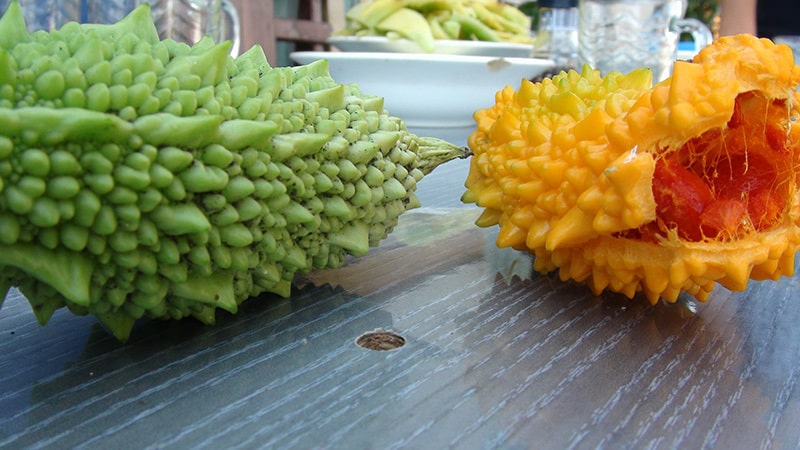
Thanks to its rich composition, the vegetable has an extensive list of beneficial properties. Therefore, it is actively used in folk medicine and even used for weight loss.
Useful properties of momordica:
- increasing the intensity of metabolic processes;
- cleansing the body of waste, toxins and bad cholesterol;
- activation of the immune system;
- strengthening the secretory function of the pancreas;
- decreased blood sugar levels;
- increased hemoglobin levels;
- removal of free radicals;
- increased visual acuity;
- reduction of inflammation;
- antimicrobial effect;
- eliminating itching and swelling from insect bites.
Note! There is information online that Momordica charantia has anti-cancer, anti-diabetic properties and the ability to suppress HIV. This information has not been scientifically confirmed. Such self-medication is dangerous to life and health.
Damage from momordica
Before eating momordica or using it for medicinal purposes, you must Check out the possible side effects:
- abortifacient properties;
- allergic reaction;
- cough and sore throat;
- decreased blood sugar levels;
- tremor of the limbs;
- nausea and vomiting;
- temperature increase;
- digestive disorders.
Typically, such problems arise when there are contraindications to the use of Momordica charantia or when it is used in excessive quantities.
Growing stages
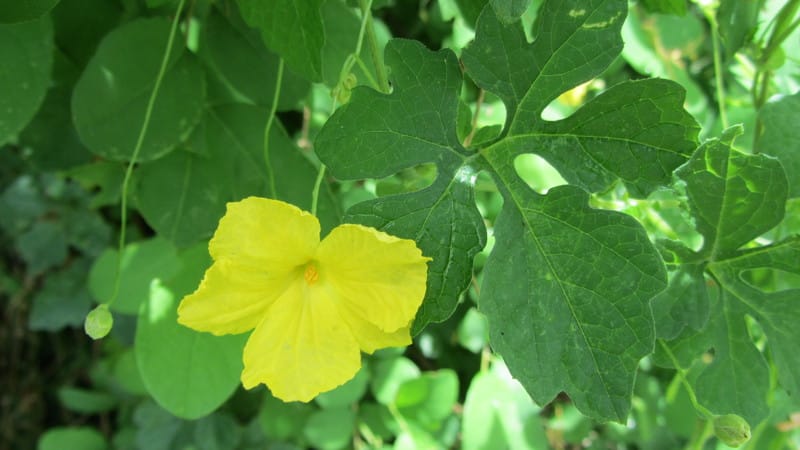
Chinese bitter gourd is also grown in our country. This vegetable is found on sale in the markets of southern cities.
Momordica is cultivated in warm regions in open ground. The plant has a decorative appearance, so it is often planted along fences.
In regions with more extreme climates, the vegetable is planted in protected soil. Possible to grow on a balcony or windowsill.
Planting seedlings
In our climate, it is most convenient to grow momordica using seedlings. In this case, the chances that the plant will take root and have time to bear fruit are much greater. Work with seeds begins in the second half of April.
Before you start growing seedlings, you need to prepare planting material:
- Reduce the thickness of the seed shell by sanding it. The main thing is not to wipe the shell through.
- Soak the seeds for 30 minutes in a solution of potassium permanganate. This will protect the plant from diseases.
- Place the planting material in a container with warm, damp sawdust. Cover the container with film and place in a warm place. When the seeds open, they are ready to plant.
It is recommended to sow seeds in separate containers. It is best to use peat pots for this.
For momordica, a soil mixture is prepared from equal portions of peat, sand and humus. The store sells universal soil for seedlings, which is also suitable for growing bitter gourd.
The soil is disinfected before use by calcining it in the oven or spilling it with a strong solution of potassium permanganate.
Then the soil is watered with warm, settled water and the seeds are placed in it, deepening them by 2-3 cm. The containers with the seeds are placed in a warm place.
When the seeds germinate, they are placed in a room with a temperature of 16-17°C for a week. Then they are returned to the heat. This will help prevent the seedlings from being pulled out.
Water the plants as the soil dries out. The liquid should be warm. It is important that it does not fall on the above-ground part of the plant.
Momordiki do not feed seedlings. There are enough nutrients in properly prepared soil.
Two weeks before planting in the ground, seedlings should be hardened off. To do this, the plants are taken outside, gradually increasing the time they spend there.
Transplantation to a permanent place
For vines, momords choose the sunniest area of the garden. It is dug up and cleared of weeds. Humus or chicken droppings are added to the soil. If the acidity of the soil is increased, add ash or dry lime.
Chinese bitter gourd is planted in open ground when the soil warms up. This occurs at the end of May or beginning of June.
The holes are dug at a distance of 80 cm from each other. Complex mineral fertilizers are poured into them. Plants are placed in recesses along with a peat pot. The root collar should not be deeply buried, but there is no need to leave the roots bare either.
Plant care
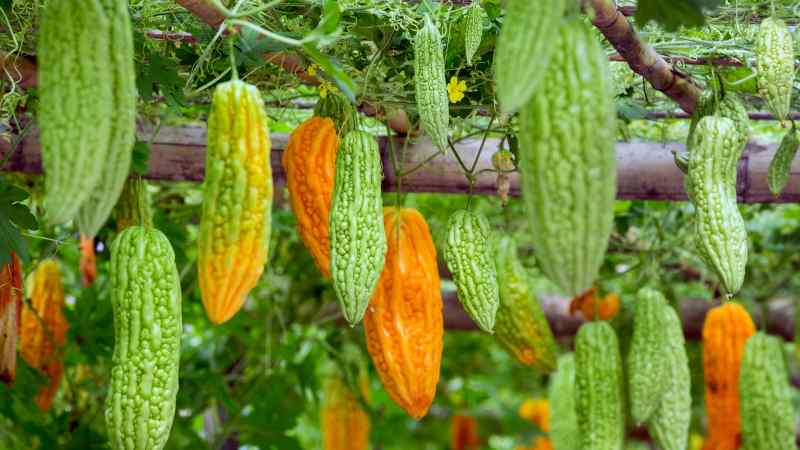
Momordica charantia is a tall plant that needs staking. To do this, use high, strong supports. Another option is to plant bitter gourd near the fence.
The liana must be pinched, forming 3-4 stems, and excess shoots and leaves removed. If the greenery is too thick, there will be few fruits.
Momordica is a moisture-loving plant. It needs to be watered at least three times a week. One vine uses 10 liters of water. Water in the morning or at sunset. This will reduce the likelihood of burns on the leaves.
When watering, the roots of momordica are often exposed, so they are covered with earth.
Feed the vegetable once every three weeks. They use complex fertilizers that contain nitrogen, potassium and calcium.
Harvesting
The harvesting time of Momordica charantia depends on which part the gardener needs:
- Seeds with pericarp are consumed when ripe. They are harvested when the fruits turn orange.
- The pulp has a pleasant cucumber taste. It is used to prepare traditional Asian hot dishes. The pulp of bitter cucumber is edible when the fruits reach large sizes but are green in color.
- Seeds for planting are harvested after the fruits have cracked.
- Young leaves are harvested in early June.
- The roots are harvested at the end of October. They are dried in a dry, dark place.
- Flowers are also used to prepare hot dishes. They are collected when the plant is flowering.
Momordica fruits are stored at room temperature for only three days. They do not spoil in the refrigerator for up to three weeks.
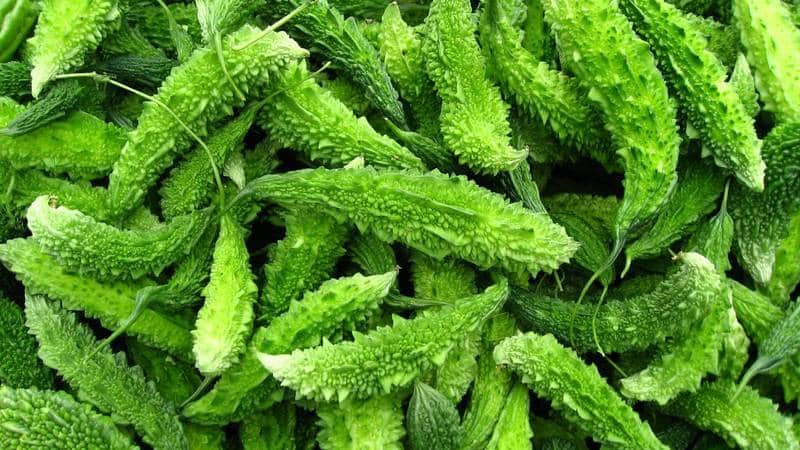
Uses of bitter cucumber
In ancient times in Asia, only members of the emperor's family were allowed to eat the fruits of Momordica charantia. Now anyone can try the vegetable, which was once a symbol of aristocratic origin.
Bitter gourd is used not only for food. In folk medicine there are recipes with different parts of this plant. There are even homeopathic medicines that contain Momordica charantia.
In cooking
Those who love to cook national dishes from around the world have probably come across Asian recipes with momordica charantia. Buying this vegetable in a store is a great success, but growing it on your own plot is not difficult.
There are many recipes for Asian dishes with momordica. Below are the most interesting ones:
- Pork with bitter gourd. 0.5 kg of pork is cut into thin strips. Fry the meat in a wok until golden brown. Add green momordica cut into slices. When the vegetables and meat are ready, add 100 ml of soy sauce, 1 tbsp. l. vinegar and 1 tbsp. l. sesame seeds. Simmer for another 5 minutes. Served with rice.
- Fried momordica. The firm green fruits are cut into rings and soaked in salt water for 30 minutes. Then they are rolled in flour with the addition of turmeric and salt. Fry in plenty of oil until golden brown.
Green momordica fruits are pickled. The ruby-colored pulp of ripe fruits is consumed fresh.
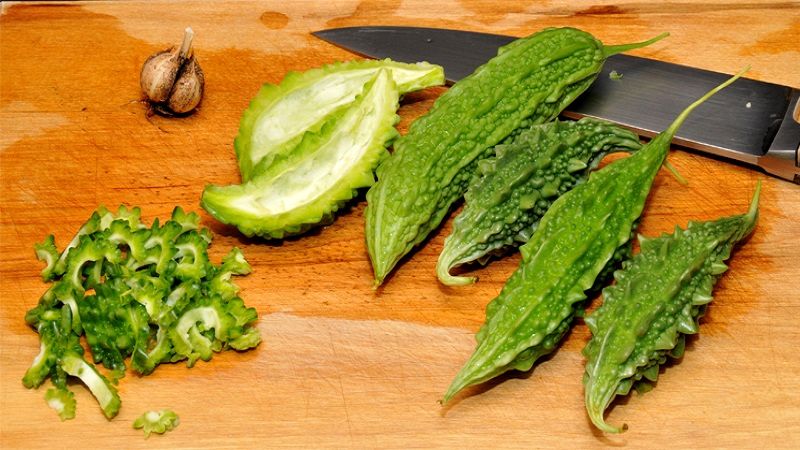
In folk medicine
Momordica has been used in folk medicine for several hundred years. Chinese healers prepared alcoholic tinctures from it for colds, genitourinary infections and diabetes.
Decoctions of Chinese bitter gourd leaves are used in folk medicine to treat alcoholism and smoking addiction. They are also used to treat prostatitis and hemorrhoids.
Contraindications
In some cases, momordica can bring harm rather than benefit to the body. It is important to know in what cases it is prohibited to consume this vegetable:
- during pregnancy;
- during lactation;
- children under 16 years of age;
- in case of an allergic reaction.
The fruits should be consumed with caution by people with diseases of the adrenal glands, thyroid gland and gastrointestinal ulcers.
Farmer reviews
Reviews from gardeners about momordica are mixed. Not everyone likes the unusual taste of this vegetable.
Irina, Sochi: «I have been planting Momordica charantia along fences for several years now. It looks very interesting during fruiting and flowering. I tried to cook Asian dishes with green fruits. Tasty, but it would have been no worse with pepper. The ripe red pulp is sweet with a pumpkin flavor. I won’t say that it’s very tasty, but it’s healthy. That’s why we eat it as a family.”
Igor, Belgorod: “I tried Chinese bitter cucumber for the first time in Crimea. At first the taste was not impressive at all: the slimy sweet red pulp with huge seeds had a strange taste. Later I found out that this is a momordica that can be grown in my city. Last year I planted a couple of vines for testing near the fence. They looked very unusual, all the neighbors came to look. I still don’t understand the taste, but they say that it is a very healthy vegetable. In the future I plan to plant for decoration.”
Read also:
What does the decorative turban-shaped pumpkin “Little Red Riding Hood” look like?
Decorative pumpkin: growing unusual fruits.
How to grow a Cio-Cio-san tomato in open ground or a greenhouse.
Conclusion
Momordica charantia is a healthy exotic vegetable. It is used for preparing main courses, snacks and eaten fresh. Chinese bitter gourd has also found its use in folk medicine. Growing momordica in our country is not difficult. You just need to follow all the rules for planting seedlings and caring for the plant.